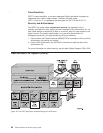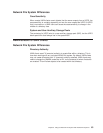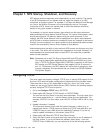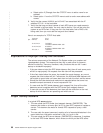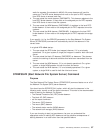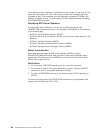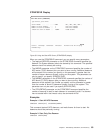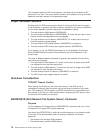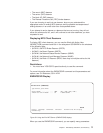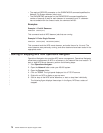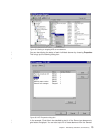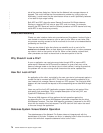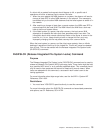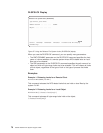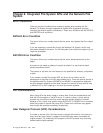
This command starts the NFS mount daemon, and waits up to the default of 30
seconds for it to start. The mount daemon should not be already running, and other
daemons have been started in the appropriate order.
Proper Shutdown Scenario
Shutting down an NFS server properly allows for all jobs to finish and all requests
to be completed. In general, the order of actions required for the server to shutdown
are the exact opposite of actions required for the server to startup:
1. The user ends the NLM daemon (QNFSNLMD).
2. The user ends the NSM daemon (QNFSNSMD). All locks that are held on local
files by remote client applications are disengaged.
3. The user ends the mount daemon (QNFSMNTD). All remote client mounts of
local file systems are disengaged.
4. The user ends the NFS server daemon (QNFSNFSD) or daemons.
5. The user ends the RPC binder (port mapper) daemon (QNFSRPCD).
If you specify *ALL for the SERVER parameter for the End Network File System
Server (ENDNFSSVR) command will automatically end all the daemons in the
correct order.
The order of client shutdown processes is generally the opposite from which the
user starts the processes.
1. The user ends the NLM daemon, if it exists on the client. A single server NLM
can operate for both the client and server.
2. The user ends the NSM daemon, if it exists on the client. A single server NSM
can operate for both the client and server.
3. The user ends the block I/O daemon (QNFSBIOD) or daemons.
4. The RPC binder (port mapper) daemon is ended.
Shutdown Consideration
TCP/UDP Timeout Conflict
When ending the NFS server, the socket port closes. If the NFS server is
immediately re-started, then the server may not be able to connect to the socket
port. The underlying TCP/IP support on AS/400 renders this port unavailable for a
short period. If you wait for a short period before re-starting the NFS server, then it
will connect to the socket port as usual.
ENDNFSSVR (End Network File System Server) Command
Purpose
The End Network File System Server (ENDNFSSVR) command ends one or all of
the Network File System (NFS) server daemons.
You should use SERVER(*ALL), which will end the daemons in the following order.
(This order is the recommended order for ending the Network File System
daemons.)
v The network lock manager (NLM) daemon
v The network status monitor (NSM) daemon
70 OS/400 Network File System Support V4R4



